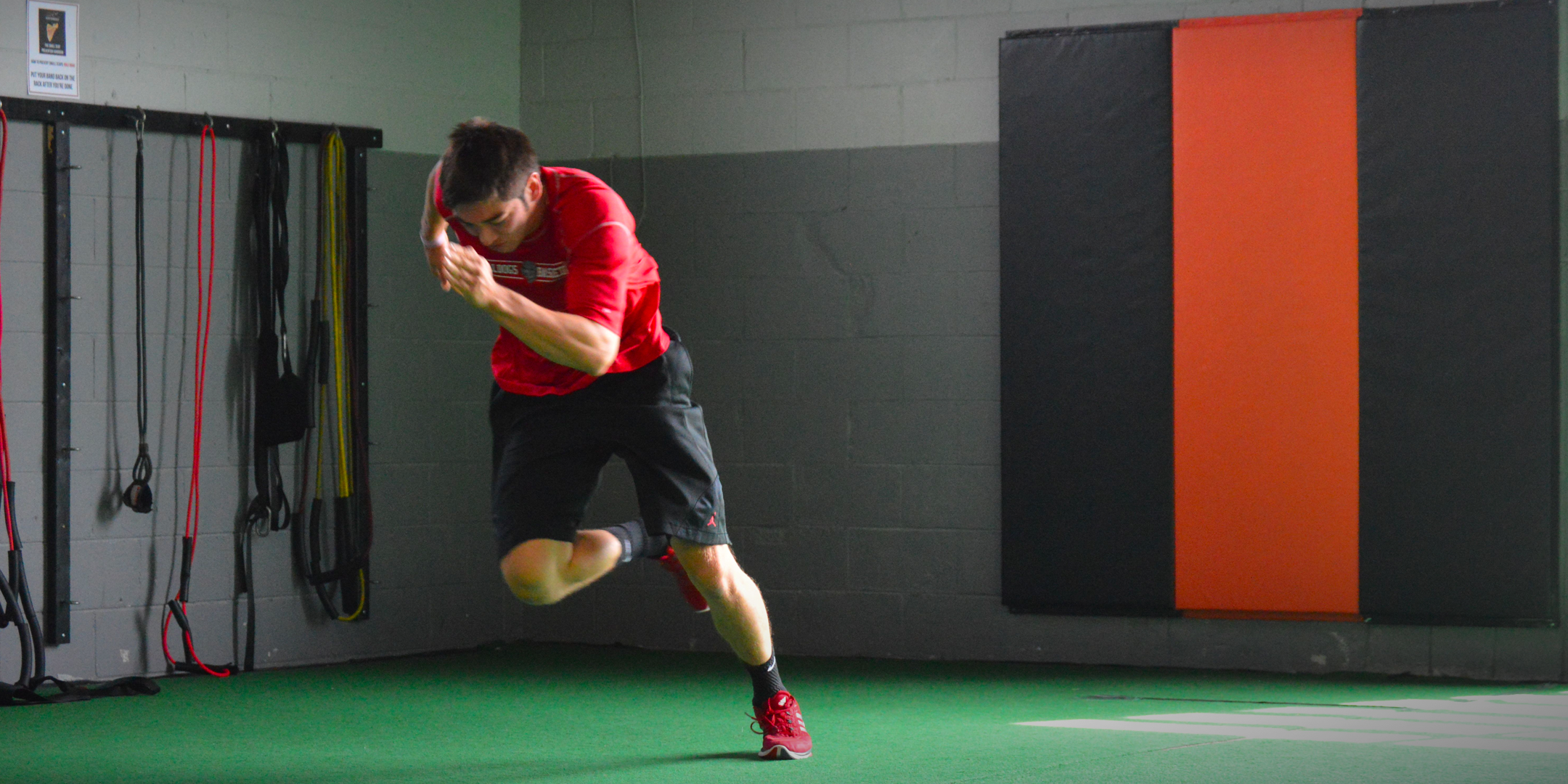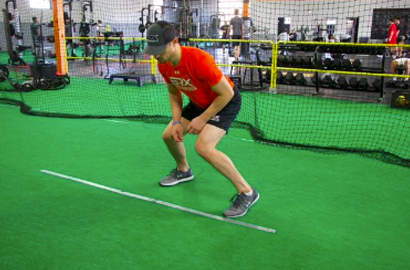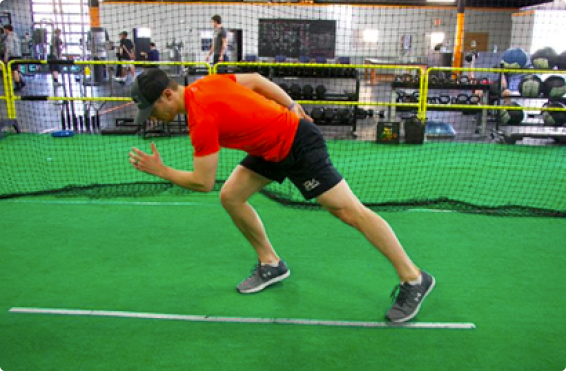6 Baseball Showcase Tips For Infielders
February 18, 2021
Infielding The infielding portion of a showcase is where strategy plays a critical role.
Although improving a 60-yard dash takes time, there are some useful tactics that can have a dramatic effect on your score. The rest of this guide goes into further detail on what we use with our athletes to help them improve their 60-yard dash time. If you're serious about improving your 60-yard dash time, follow this link to our free 5 part video series on how to improve your 60 time.


There are two primary things that drive us bonkers when it comes to athletes setting up for the 60-yard dash:
In regard to number one, think about this question: are you in any danger of getting picked off by a pitcher when you set up for your 60-yard dash at a showcase? Of course not – so don’t set up as if you’re about to get picked off by the world’s best pick-off artist!
Setting up with your feet even with each other closes off your front hip, which is a first-move and acceleration killer. So here’s what we’re going to do: drop your right foot back 6-12 inches, which will open up your right hip and make it easier to turn 90 degrees right out of the gate.
In regard to number two – being flat-footed – here’s another question for you: if you were trying to dunk a basketball, would you start with your feet flat on the ground, or would you be on the balls of your feet? Of course, you’d be on the balls of your feet, because it allows you to be more explosive.
Think of the first move of the 60-yard dash as just like a jump (figuratively, not literally): the more explosively you push your left foot into the ground, the more distance you’ll cover with your first stride.
Here’s the main message: make sure you’re on the balls of your feet with your heels at least an inch off the ground. You’ll feel considerable tension in your legs, which will allow you to explode out of the gate.

Building off of tip #1, turn both feet slightly towards the finish line.
This will help open your hips even more and put your left foot (trail leg) into a much better position to do two things simultaneously on your first move:
The one big mistake many athletes make with this tip is turning their shoulders along with their feet. DON’T DO THIS!
This looks like blatant cheating to the person running the showcase and will likely lead to them telling you to reposition your body to look more like you’re stealing a base.
In essence, turn your legs towards the finish line, but keep your upper body motionless.

The next thing you’re going to think about is turning your left knee towards the finish line.
This creates what’s called a “positive shin angle,” which you can think about this way: your left knee being closer to the finish line than your left foot.
A positive shin angle allows you to optimize how much force you’re applying into the ground, which will lead to more ground covered with your first step.
Again, just like the previous tip, make sure your shoulders are not turning with your knee!

Arguably the most important portion of the 60-yard dash acceleration phase is the very first move.
As a result, it’s important that it’s as explosive as possible. The best way to make this happen is by “syncing up” your left arm and your left foot.
To set yourself up for this, make sure your left arm is loaded backwards and elbow is at a 90 degree angle.

One of the most overlooked portions of the 60-yard dash is the second move – the right leg’s first push.
In order to have an optimal first push of your right leg, it’s important to orient your bodyweight in a position that will lead to a slight forward lean after your first move.
This is why we set up with 60% of the weight on your right (front) leg: after the left leg pushes through the ground for the first move, you’ll be in a great, athletic position to do the same with your right leg.

Building off the tip above regarding the left arm being loaded backwards, we’re going to talk about the most important portion of your acceleration: the first move. We like to have athletes think about the first move as being “frozen to explosion,” which we’ll explain in a bit.
First, let’s discuss one of the big acceleration killers: something we call the “buildup start.”
The buildup start is when there’s a noticeable gap between being completely still on the set-up and explosive movements during acceleration.To the naked eye, it looks like an athlete isn’t even trying as hard as possible until their 3rd or 4th step (although it’s not intentional).
Our goal is to eliminate this middle ground or “buildup start.”
This is why I like having athletes think about the first move as “frozen to explosion” – as soon as you begin your first move, you’re thinking about moving your arms and legs as explosively as possible. To get a better understanding of what "frozen to explosion" looks like, click here.
This entire process begins by pushing your left foot explosively through the ground at the exact same time that your left arm “rips” forward towards the finish line.
This will do three primary things:
It’s not uncommon for athletes to improve their 60-yard dash by two to three tenths simply by mastering this single tip
Another acceleration killer is standing too tall, too soon.
While you want to “get tall” during top speed, you want to think about driving your legs through the ground for the first 20 yards.
The reason? Driving your legs through the ground applies more force into the ground, which helps you cover more ground with each stride. This is the source of a faster time!
Your body will get tall naturally without having to think about it at around the 20- 30-yard mark if you do this correctly.

While there are no “magic tips” for making significant improvements to top-end speed, there are few things that can help.
One is staying tall from yards 30 to 60. Many athletes absolutely kill their time by getting their upper body too far out in front of their lower body when they start to tire out between yards 40 and 60. Also, many athletes lose out on lower body force production by not bringing their knees high enough at top speed.
While you shouldn’t think about doing a high-knee warm-up drill, make sure you are being explosive by driving your knees up to a 90-degree angle when compared with your torso.
This will increase how much force you apply into the ground with each stride, which will cover you more ground and lower your time.
Another 60-yard dash killer that gets SO many athletes is not running in a straight line!As simple as it is, make sure you are keeping your eyes on the finish line so you run in a completely straight line!
All too often we see athletes keep their head down, which can lead to several feet of deviation from the optimal running lane.
As you know, the fastest path between two points is a straight line – avoid the banana path!
Here’s another tip we wish went without saying: run through the finish line!
Many athletes cost themselves precious tenths by coasting for yards 55 through 60 – makes sure you run through the line!
If you are having trouble understanding what these steps look like in motion, you can get access to our free 60-yard dash video series here. (CLICK HERE)
Are you struggling to increase your throwing velocity, exit velocity, or running speed? Don't worry; you're not alone. That's why we have developed BDS, Baseball Development Secrets. The Baseball Development Secrets System (BDS) is a baseball-specific strength training program specifically designed to increase throwing velocity, exit velocity, and running speed. The best part is you can get access to our program for 7 days free of charge! If you're serious about your baseball development, Baseball Developments Secrets could be that answer for you as it has been for hundreds of other baseball players. Start your FREE trial today!
February 18, 2021
Infielding The infielding portion of a showcase is where strategy plays a critical role.February 18, 2021
1) Protein shake (with whole milk) The hands-down easiest way to build muscle mass is to add two...March 26, 2021
New Rules in Baseball Strength Training Series Imagine this scenario: you’re the overall strongest...